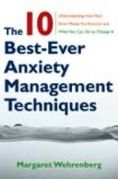Anxiety
What's the First Step Toward Reducing Needless Anxiety?
This is the most important decision you can make to calm your anxious brain.
Posted March 11, 2014
Mother Nature wants you to be anxious.
Although that doesn’t seem like such a loving wish for a mother, Mother Nature is interested in your survival. So she made sure you would pay attention to anxious feelings to protect you from fearsome things—like lions or tigers or bears or, maybe worst of all, an aggressive homo sapiens.
Our brains have adapted to automatically react more strongly and remember more vividly when events, comments, or people are perceived as negative or threatening. This phenomenon has been labeled the negativity bias. We also have a highly evolved stress response system which can mobilize the fight-or-flight response when we perceive danger.
As you know, these hard-wired responses works just fine when danger really does threaten you. But when something is unlikely to happen, chronic anxiety and worry just become unpleasant feelings that serve little purpose. In fact, stress hormones coursing through your body for hours on end can fill you with painful inner turmoil and be hazardous to your health.
So, if you resort to the mental habit of anxiety even when you are not in danger, what is the first step toward making your mind a more peaceful place?
Take a guess. Is learning to relax the first step? How about deep breathing exercises or meditation? Would replacing your worrisome thoughts with soothing thoughts be the most important first step toward reducing chronic anxiety?
All of the above are awesome techniques for reducing anxiety and worry. (I’ll be describing such techniques—and more—in my next blog.) But none wins the prize as the essential first step to take if you desire to manage your anxiety. Rather, the first step is this:
Make the decision to use the thinking part of your brain to override your automatic anxiety.

Since anxiety has been hard-wired into your brain by Mother Nature (a.k.a., natural selection), it's easy for it to take over. To counter it, you will need to be mindful. First, notice when you’ve gotten stuck in an anxiety thought pattern. Then, make the deliberate and conscious decision to use your "higher brain" to manage your worry. Your "higher brain" is the pre-frontal cortex (PFC), the thinking part of your brain. As the CEO of your brain, the PFC can analyze the situation and decide which anxiety management technique can help you calm your anxious brain in a particular situation.

This first step is suggested by Margaret Wehrenberg in her book, The 10 Best-Ever Anxiety Management Techniques. As she puts it, “You automatically gain a certain measure of control over anxiety when you say to yourself, “This is my brain doing this. It is not me, and I can control it.” Your mind can actually learn to control your automatic brain—an amazing feat.
It’s reassuring to know that the decision to take charge of your anxiety can itself provide some relief. You’re going to take the wheel of control. Whew! I feel better already. You?
© Meg Selig, 2014
Watch for my next blog to learn about specific techniques for managing anxiety! Meanwhile, you might benefit from "Three Quick Ways to Curb Catastrophic Thinking."
Meg Selig is the author of Changepower! 37 Secrets to Habit Change Success (Routledge, 2009). For more on mental habits, health, and happiness, she invites you to follow her on Twitter and Facebook.
For more on anxiety and the brain, see this blog by Melanie Greenberg.
Source:
Wehrenberg, M. (2008) The 10 Best-Ever Anxiety Management Techniques (NY: W.W. Norton)
Great definition of anxiety here: http://en.wikipedia.org/wiki/Anxiety




